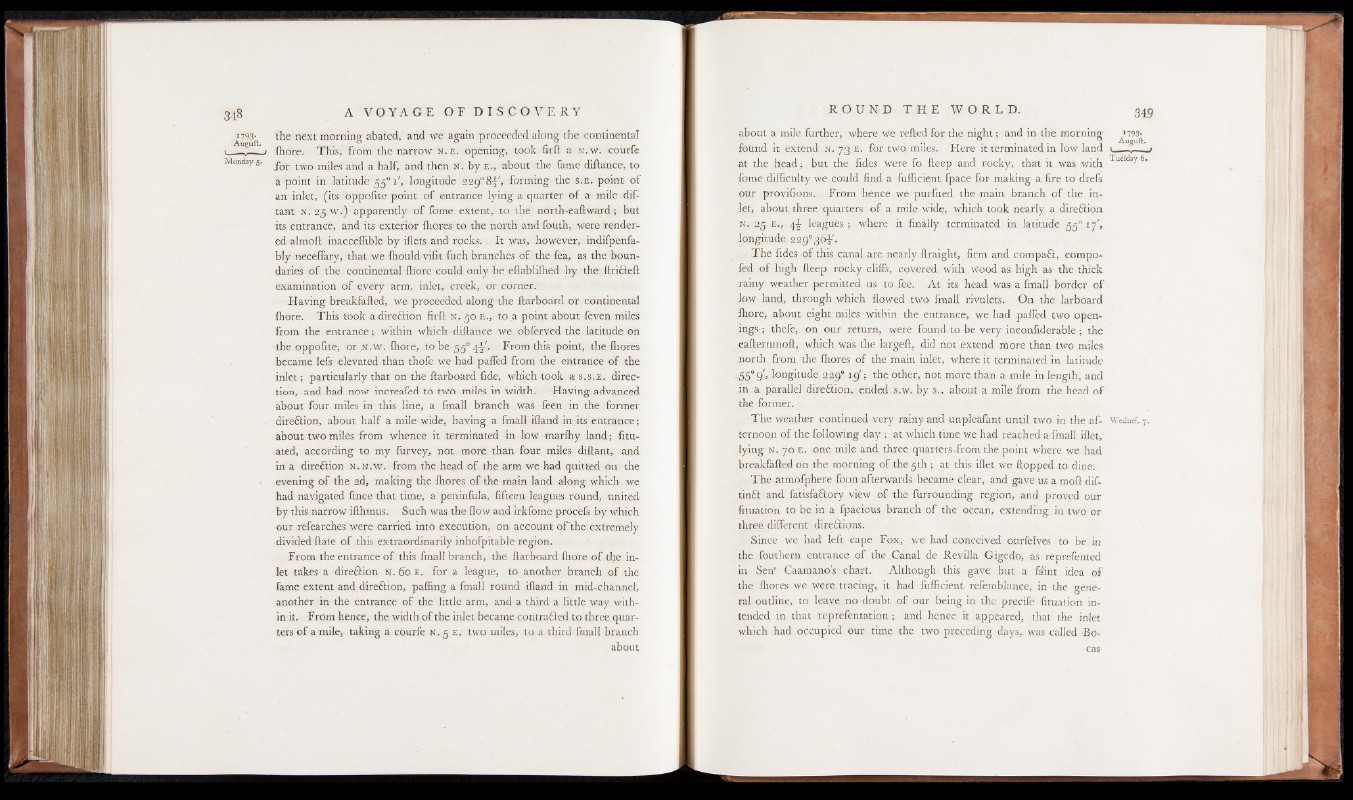
»793- the next morning- abated, and we a rain proceeded alone the continental
Auguft. 8 8 r . , c n r
■ ■ fhore. This, from the narrow n . e . opening, took hrlt a n .w . courle
Monday 5. ^ two mi[es ang a half, and then N. by e ., about the fame diftance, to
a point in latitude 55° i', longitude 2 29° 8^-', forming the s .e . point of
an inlet, (its oppolite point of entrance lying a quarter o f a mile dif-
tant n. 25 w .) apparently o f fome extent, to the north-eaftward; but
its entrance, and its exterior Ihores to the north and fouth, were rendered
almoft inacceflible by iflets and rocks. It was, however, indifpenfa-
bly neceflary, that we Ihould vifit fuch branches of the fea, as the boundaries
of the continental Ihore could only be eftablifhed by the ftri6teft
examination o f every arm, inlet, creek, or corner.
Having breakfafted, we proceeded along the ftarboard or continental
Ihore. This took a direftion firft n . 50 e ., to a point about feven miles
from the entrance; within which diftance we obferved the latitude on
the oppolite, or n .w . fhore, to be 55° 4 y. From this point, the fhores
became lefs elevated than thofe we had pafled from the entrance o f the
inlet; particularly that on the ftarboard fide, which took a s.s.e . direction,
and had now increafed to two miles in width. Having advanced
about four miles in this line, a fmall branch was feen in the former
direction, about half a mile wide, having a fmall ifland in its entrance;
about two miles from whence it terminated in low marlhy land; fitu-
ated, according to my furvey, not more than four miles diftant, and
in a direftion n . n .w . from the head of the arm We had quitted on the
evening of the 2d, making the fhores of the main land along which we
had navigated fince that time, a peninfula, fifteen leagues round, united
by this narrow ifthmus. Such was the flow and irkfome procefs by which
our refearches were carried into execution, on account o f the extremely
divided ftate of this extraordinarily inhofpitable region.
From the entrance of this fmall branch, the ftarboard fhore o f the inlet
takes a direftion n. 60 e . for a league, to another branch o f the
fame extent and direction, palling a fmall round ifland in mid-channel,
another in the entrance o f the little arm, and a third a little way within
it. From hence, the width of the inlet became contrafted to three quarters
of a mile, taking a courfe n . 5 e . two miles, to a third fmall branch
about
about a mile further, where we relied for the night; and in the morning
found it extend n . 73 e . for two miles. Here it terminated in low land
at the head; but the fides were fo fteep and rocky, that it was with
fome difficulty we could find a fufficient fpace for making a fire to drefs
our provifions. From hence we purfued the main branch of the inlet,
about three quarters o f a mile wide, which took nearly a direflion
n. 25 e ., 4|- leagues ; where it finally terminated in latitude 55“ 17',
longitude 229° 365-'.
The fides of this canal are nearly ftraight, firm and compafl, compo-
fed of high fteep rocky cliffs, covered with Wood as high as the thick
rainy weather permitted us to fee. A t its head was a fmall border of
low land, through which flowed two fmall rivulets. On the larboard
fhore, about eight miles within the entrance, we had pafled two openings
; thefe, on our return, were found to be very inconfiderable; the
eafternmoft, which was the largeft, did not extend more than two miles
north from the Ihores of the main inlet, where it terminated in latitude
-55“ 9', longitude 229“ 19'; the other, not more than a mile in length, and
in a parallel direftion, ended s.w. by s., about a mile from the head of
the former.
< The Weather continued very rainy and unpleafant until two in the afternoon
of the following day ; at which time we had reached a fmall iflet,
lying n . 70 e . one mile and three quarters.from the point where we had
breakfafted on the morning of the 5th ; at this iflet we flopped to dine.
The atmofphere foon afterwards became clear, and gave us a moft dif-
tinft and fatisfaclory view of the furrounding region, and proved our
fituation to be in a fpacious branch o f the ocean, extending in two or
three different direftions.
Since we had left cape Fox, we had conceived ourfelves to be in
the fouthern entrance of the Canal de Revilla Gigedo, as reprefented
in Sen'- Caamano’s chart. Although this gave but a faint idea of
the fhores we were tracing, it had fufficient refemblance, in the general
outline, to leave no doubt of our being in the precife fituation intended
in that reprefentation ; and hence it appeared, that the inlet
which had occupied our time the two preceding days, was called Bo-
Wednef. n.
cas